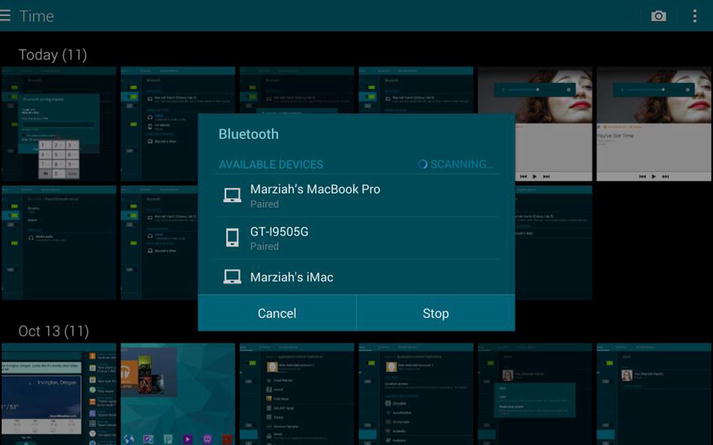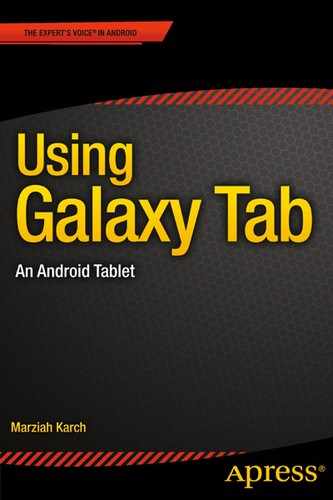The Galaxy and the Rest of the Universe
In the last chapter, we looked at using your Tab for fun and for business. In this chapter, it’s all about the accessories. Let’s look at using a Tab with Bluetooth devices, watches, phones, TVs, and more.
The Universe of Bluetooth
Bluetooth is a short-range wire replacement technology. With Bluetooth, you can do many things that would otherwise have required that you plug something in, such as connecting devices to keyboards, mice, headphones, and printers. You can also use Bluetooth to transfer files between devices without using a USB cable or Wi-Fi connection. Thanks to improved Bluetooth technology, you can even listen to your music in stereo.
The name Bluetooth came from a Danish Viking credited with uniting Scandinavians, King Harald Blåtand. His name is roughly translated as “blue tooth.” The idea is that just as King Blåtand united Denmark, Bluetooth technology unites all your devices.
There are a lot of technical terms associated with Bluetooth technology, but it’s not my intent to bog you down with jargon. We’ll explore extending your tablet with Bluetooth and using devices such as keyboards and headphones or transferring files to your laptop.
Note You must have a compatible Bluetooth adapter or device in order to stream music or use keyboards on your tablet. Not all devices are compatible with each other.
If you’re going to use Bluetooth on your device, you need to make sure that it’s active:
- Tap on Settings
- Tap on the Connections tab (if not already selected)
- Tap on Bluetooth
- Move the slider from off to on
Figure 6-1 shows Bluetooth enabled.

Figure 6-1. Active Bluetooth waiting to find devices
If you want to pair your device with computers or phones, you’ll also need to check the box next to the Galaxy Tab S in the list to allow other devices to see it. By default, it is only visible to paired devices. This is for security. Once you’ve paired your Tab with your phone or computer, you can set the visibility to paired devices only.
Bluetooth profiles determine how devices interact with each other and control things such as printing, transferring files, playing sounds, and using devices such as joysticks. In order to be compatible, both items have to understand the same profile. That means that you’ll have to check with your tablet and your device to make sure that they’re compatible. As a rule of thumb, they usually are.
The Galaxy Tab S supports:
- A2DP (Advanced Audio Distribution Profile)—used for streaming audio to headphones
- AVRCP (Audio Video Remote Control Profile) —used for remote controls for your tablet
- DUN (Dial-Up Network)—used for tethering and modems
- FTP (File Transfer Protocol) —a method for transferring files
- OPP (Object Push Profile)—another method of transferring files from one device to another
- PBAP (Phone Book Access Profile) —used to access or transfer your contact list
Bluetooth can communicate with other devices up to 30 feet away, but it has to know which device to communicate with. You can’t just have random devices controlling each other and sending data. The process of connecting two Bluetooth devices with each other is called pairing. Not all devices are compatible with each other, so not all devices can be paired.
Pairing with phones uses the same process, but there’s one key detail that you don’t want to forget: both devices need to be discoverable. Both your tablet and your phone are generally not discoverable by default, so you’ll want to make both devices discoverable (see Figure 6-1).
Pairing with Keyboards and Headsets
Accessories such as keyboards and headphones are easy to pair because they use a simplified system. Let’s walk through pairing a simple, portable speaker.
Go into your Bluetooth settings (Figure 6-1). Most Bluetooth headphones, keyboards, and speakers have some sort of button to press or hold down that will cause the accessory to go into discovery mode. Press it, and then tap “Scan” to find a list of available devices (Figure 6-2).

Figure 6-2. Scan for devices
Notice how the two devices that Bluetooth found have two different symbols. Tap on the CANZ device to pair it. The pairing is already in process in Figure 6-2.
Once it is paired, you’ll see a “settings” icon next to the device, along with a message that it is connected (Figure 6-3).

Figure 6-3. The speaker is paired
The settings allow you to specify that you want the speaker to play all media (meaning all the movies and music) or unpair the device.
Once you’re paired, the tablet will assume that you want to use the paired device whenever it is in proximity. You won’t need to repair the devices unless one device is somehow reset to factory defaults.
Computers and phones require a slightly more complicated two-step pairing, in which you must confirm the pairing on both devices. On older computers and some devices (including the LEGO EV3), you may have to type a number into the tablet and computer (Figure 6-4).

Figure 6-4. Pairing when numbers are required
However, on many newer computers and phones, you just have to confirm that a number matches on both your tablet and the device. The process is the same on a computer as it is on a phone. Figure 6-5 shows the simplified dialog.

Figure 6-5. The simplified pairing dialog
Note The reason that you have to confirm or enter a number on both devices is because there may be another device with a similar name on the network. This prevents confusion and adds a layer of security just in case.
Now, why would you want to pair your phone or your computer? Easy file transfer. Not to get too meta, but Figure 6-6 shows a Bluetooth transfer of images. The images, which you can see in the background, were actually the screen captures used to write this chapter. Rather than using a cable to connect the tablet to a computer or using a third-party service like Dropbox or Google Drive, I just transferred these files from the Galaxy Tab to my computer’s hard drive.
- Go to the Pictures app
- Select a picture
- Press the options button (the three dots on the upper right corner of the screen)
- Choose Share by Bluetooth
- Choose a device

Figure 6-6. Using Bluetooth to transfer files
Using a Keyboard
Keyboards pair just like speakers. You find the button to enable Bluetooth discovery. You pair the keyboard.
You may want a keyboard if you’re doing a lot of typing on office apps. You can essentially turn your tablet into a netbook in a pinch. I wouldn’t say it’s quite a desktop replacement, but 10-inch keyboards are surprisingly easy to use.
When your keyboard is off, the onscreen keyboard will appear as usual.
Remember that one of the supported Bluetooth profiles (AVRCP) is used for remote controlling other devices. Many keyboards offer options to play media and music, launch apps, start instant messaging, or browse the Web.
Your Samsung Galaxy Tab S also comes with a built-in TV remote for Samsung (and a few other brand) TVs. By using the WatchOn app that comes with your Galaxy Tab S, you can use your tablet as a TV guide, set yourself a reminder to watch your favorite show, and then use the TV remote control to tune the TV (Figure 6-7).

Figure 6-7. The WatchOn app
Tap on the remote button on the bottom right corner, and the app will take you through the process of setting up your remote (Figure 6-8).

Figure 6-8. The remote is being set up
This is not Bluetooth pairing. The Samsung Galaxy Tab S actually comes with an infrared blaster that signals to the TV. Different TV models have different codes, so the app figures out the codes that will work with the individual device.
If you have a Roku, you can download the Roku app to control it, but you can also transfer pictures to the Roku using network sharing.
Google introduced this $35 streaming wonder, and it’s actually pretty wonderful. If you purchase or rent Google Play movies (such as the free Hunger Games movies that come as a limited time promotion with the Galaxy Tab S), you can simply hit the “cast” button and send the movie to your TV. This also works with music.
Android introduced a new version of Android just for watches, called Android Wear. Previously, Samsung had a version that only ran on Samsung devices. The latest Samsung watch—the Samsung Gear Live—uses the latest Android Wear protocol. If you have a compatible Android smart watch—either one of the Samsung Gear watches or an Android Wear watch—you can use the Gear app to control your watch. You can pair your watch and tablet (this is a Bluetooth pairing) and then select the apps and media that you want to add to it. Add some songs for your daily jog, for example. Transfer photos that you took from your watch back to your tablet for editing.
Summary
In this chapter, we explored pairing devices and interacting with hardware. Use your Galaxy Tab with a variety of other devices, from keyboards and speakers to TVs and computers.
